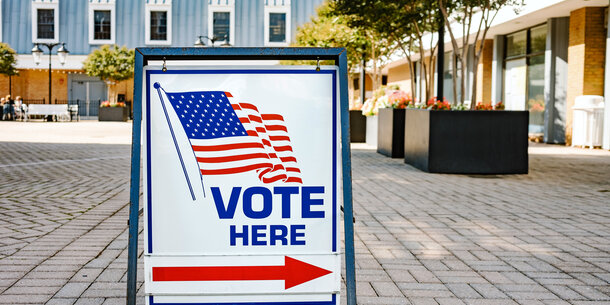As the year ends and the Georgia run-off election is underway, we should take a moment to look back at the election of 2020. The end-of-the-republic doomsday scenarios we were collectively worried about did not materialize, but voters still experienced suppression and other challenges and barriers that we as a country should not tolerate.
It would be a mistake to assume the well-publicized threats were overblown or unjustified panic. The crises that were avoided happened because advocates, community leaders, and other experts named the myriad of looming problems, galvanized public and political attention around them, and worked with communities, legislators, election administrators, and politicians to make numerous necessary improvements as quickly and effectively as possible. Concerned Americans from all walks of life took the threats seriously, rolled up our sleeves, and threw a ton of work, expertise, and money at the problems.
What were some critical things we collectively got done?
For starters, significant policy changes were implemented to make voting more accessible in the wake of the pandemic. An analysis from the Brennan Center found that 35 states changed their voting laws to make casting a ballot more accessible. Forty-five states and DC allowed any voter to vote by mail or absentee ballot this November, including eleven states that changed their rules in response to Covid-19. Nine states and DC sent all voters a mail ballot for the November election, including five jurisdictions (California, DC, Nevada, New Jersey, Vermont) that did so for the first time. At least seven states expanded their early voting hours or began offering early voting in person.
We enlisted new people to support and help our elections run smoothly. According to a Pew Research Center analysis, in 2018, 58 percent of poll workers were 61 or older, significantly impeding our ability to ensure that polling locations be adequately serviced in light of seniors’ susceptibility to Covid-19. Election officials took numerous steps to diversify the age of poll workers and replenish the pool. Michigan, for example, launched two programs to recruit both high school and college students as poll workers for the 2020 election. Across the country, young people stepped up to help in unprecedented numbers.
We leveraged support from the private sector. Businesses and philanthropists had many options for supporting citizens’ voting rights, and it is exciting that so many of them rose to the occasion. More than 1,900 companies, organized as the Time To Vote coalition, pledged to ensure their staff had time available to cast a ballot. The Civic Alliance, another nonpartisan group of businesses working to promote participation in democracy, advocated for safe access to the polls, conveyed their trust in election officials, and impressed upon Americans the need for patience as every vote was counted. Members of the beleaguered restaurant industry stepped up to serve hot meals to voters waiting in long lines at polls. And of course there was the NBA, which at the urging of its players turned 23 arenas into voting centers or polling locations.
But above all, Americans showed up to vote. This year, in the face of a pandemic, the electorate broke turnout records, reaching 66.7 percent turnout — the highest it’s been in a century.
We should all feel relieved that we could see the results of our hard work on Election Day and proud that so many Americans were not deterred. It was smart to manage expectations and be prepared for the worst, but we should never forget that Americans deserve better. While our worst fears were averted, there were still multiple failures, including voter suppression in many forms.
Voter intimidation
Voter intimidation is illegal, but there were numerous credible reports that intimidation occurred — and at higher rates than in past years. The reports came from all over the map, including in Florida, North Carolina, Georgia, New York, and Pennsylvania. The intimidation took many forms, from brandishing guns, to using trucks to block entrances, to screaming violent, racist threats at voters.
Underprepared primaries
All 50 states plus DC conducted a primary, runoff, or special election in the first six months of the pandemic. Voters waited in exceedingly long lines in many states, including Georgia, Nevada, Maryland, Pennsylvania, and DC. Wisconsin operated a mere five polling places in racially-diverse Milwaukee, and there were problems in the vote-by-mail process: 9,000 requested absentee ballots were never sent and over 23,000 ballots were never counted. Of course, the pandemic caught everyone off-guard, but it need not have. If the experience has taught us anything, it’s that emergency preparedness must be a central focus of election administration going forward.
Violent threats against elections officials
Elected officials have the thankless job of running our elections when they are under-resourced and under-supported. But worse than being under-appreciated, election officials and workers have faced threats in Pennsylvania, Nevada, Michigan, Arizona, Vermont, and Georgia. The harassment and threats of violence moved Georgia voting system official Gabriel Sterling to warn that if the baseless accusations of fraud continue, “someone’s going to get killed,” and he called on President Trump and Georgia’s two senators to denounce threats.
Congressional inaction
Despite the challenges faced by the majority of states in conducting elections during a pandemic — and the knowledge that communities of color were being hit the hardest by Covid-19 and would likely also be most severely impacted by underperforming election systems — Congress provided far too little in the way of support. The states needed an estimated $4 billion in order to properly ensure elections were free, fair, safe, and secure, but the federal government provided only a tenth of that.
Furthermore, while a House stimulus bill would have required states to make certain temporary changes to their voting systems in response to the pandemic, the final version provided no such mandate nor even guidance to states about best practices. As a result of the failure to act, states necessarily responded with a patchwork of rules and last-minute changes that created confusion and inconsistency for voters.
Frivolous lawsuits
An unprecedented number of election-related lawsuits have been filed in 2020 — more than 300 since the start of the pandemic alone. Although many of these suits were filed to increase voter access in the wake of the pandemic, the more recent flood of lawsuits overwhelmingly involved claims not backed up by evidence and whose legal arguments are clearly invalid. Since Election Day, more than 50 such lawsuits have been filed in every swing state that went blue, including Arizona, Pennsylvania, Nevada, Wisconsin, Michigan, Minnesota, and Georgia.
These lawsuits too often targeted areas with large populations of Black voters. They are not about voting rights, but instead blatantly ask courts to disenfranchise thousands or even millions of voters. Many are fueled by conspiracy theories and seem to be motivated by a desire to depress the voting strength of communities of color, cast doubt, and sow discord, more than by any realistic hope of succeeding on the merits. Indeed, these lawsuits have uniformly failed to do anything other than perpetuate conspiracy theories and the myth of voter fraud, and they function as racist dog whistles.
Misinformation and disinformation
2020 was hard enough without voters having to hear misinformation and disinformation from various quarters. Voters were faced with deceptive calls during Texas’s primary in March. Voters of color in Michigan, Pennsylvania, Ohio, Illinois, and New York were targeted by robocalls conveying false information around how their data would be shared through vote by mail. Right-wing activists targeted minority voters in Detroit and other cities with calls that discouraged them from voting, and Black and Latino voters from Florida to Arizona were targeted in disinformation efforts seeking to divide and discourage the electorate.
Moreover, bad actors, with the support of political influencers, continue lying to the public about the elections process and results. On the international front, U.S. intelligence uncovered foreign attempts to interfere in the 2020 primaries and the general election, including Russian efforts to reelect President Trump.
Our democracy survived some enormous threats. But we should not be satisfied with such a low bar for success. Instead, we need to make the necessary changes at the national, state, and local level to give every eligible voter the ability to be heard, even during chaotic times. Let’s start with pressuring Congress to get to work and approve pro-voter reforms. The John Lewis Voting Rights Advancement Act and H.R. 1 (the For the People Act) should be at the top of the list. The John Lewis Voting Rights Advancement Act would safeguard Americans against racial discrimination in voting laws by restoring the full protections of the Voting Rights Act, which was essentially gutted by the Supreme Court in 2013. The For the People Act’s comprehensive package of voting reforms would revitalize American democracy, making voting easier and more accessible, particularly for Black and brown voters being shut out by current policies, and strengthen protections against disinformation and voter intimidation.
Our system has successfully held elections during crises before, and it’s crucial that government officials do their part to ensure this is the case going forward. We need to learn from where we came up short — paying close attention to those communities who are traditionally suppressed and blocked — and do even better next time.



